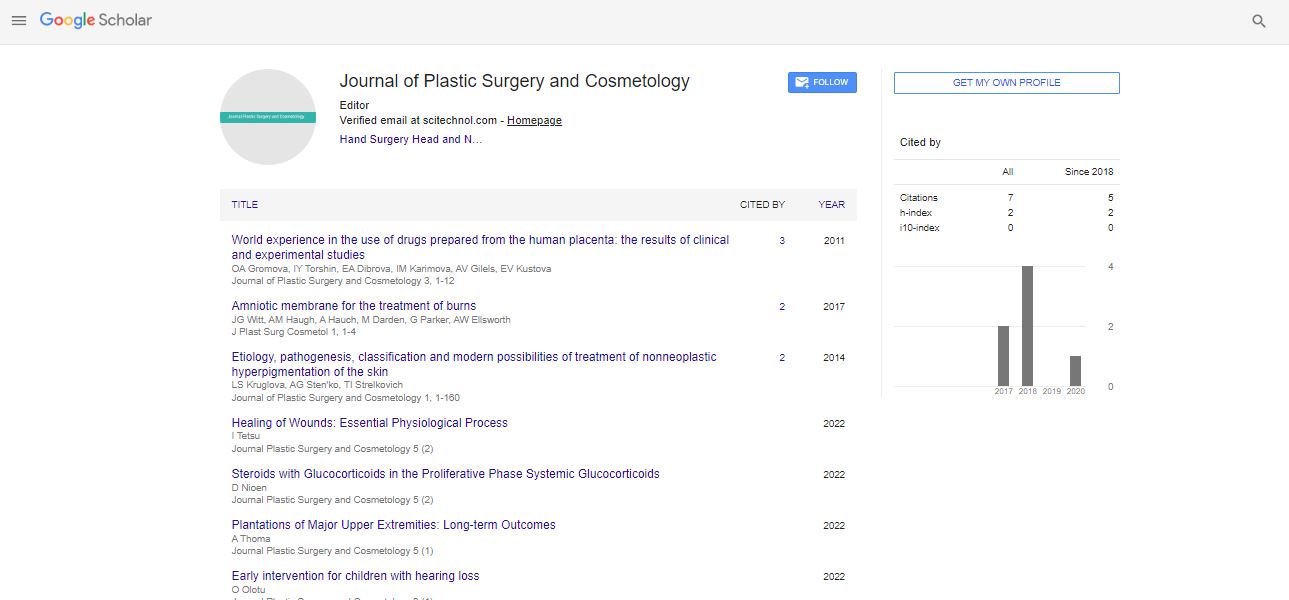Perspective, J Pls Sur Cos Vol: 12 Issue: 4
Advancements in Hair Transplantation: Robotic-Assisted Procedures and Stem Cell Therapies
Sadia Ernaz*
1Department of Pharmacy, Universitas Syiah Kuala, Banda Aceh, Indonesia
*Corresponding Author: Sadia Ernaz,
Department of Pharmacy, Universitas
Syiah Kuala, Banda Aceh, Indonesia
E-mail: Sadia_e3446@gmail.com
Received date: 27 November, 2023, Manuscript No. JPSC-24-123946;
Editor assigned date: 29 November, 2023, Pre QC No. JPSC-24-123946 (PQ);
Reviewed date: 14 December, 2023, QC No. JPSC-24-123946;
Revised date: 21 December, 2023, Manuscript No. JPSC-24-123946 (R);
Published date: 28 December, 2023, DOI: 10.4172/JPSC.1000066
Citation: Ernaz S (2023) Advancements in Hair Transplantation: Robotic-Assisted Procedures and Stem Cell Therapies. J Pls Sur Cos 12:4.
Description
Hair transplantation has undergone significant advancements in recent years, propelled by innovative technologies and novel therapeutic approaches. As the demand for effective and naturallooking solutions to hair loss continues to rise, the field has embraced robotic-assisted procedures and stem cell therapies. This essay explores the latest developments in hair transplantation methods, shedding light on how these advancements are revolutionizing the restoration of natural hair growth.
Traditional hair transplantation methods, such as Follicular Unit Transplantation (FUT), involve the removal of a strip of scalp from the donor area, typically the back of the head. This strip is then dissected into individual follicular units, which are transplanted into the recipient area. While effective, FUT can leave a linear scar and may have a longer recovery period. Follicular Unit Extraction (FUE) revolutionized hair transplantation by introducing a minimally invasive approach. Individual follicular units are extracted directly from the donor area using a punch-like instrument. This method reduces scarring and allows for quicker recovery. However, FUE can be time-consuming, and the precision of extraction may vary depending on the surgeon's skill.
Robotic-assisted hair transplantation, exemplified by systems like the ARTAS Robotic System, has brought automation and precision to the FUE technique. These systems use advanced algorithms to identify and harvest individual follicular units from the donor area with greater accuracy than manual extraction. Robotic-assisted procedures offer several advantages. The precision of the robotic system minimizes the risk of damage to surrounding follicles, leading to improved graft survival rates. The automation also speeds up the extraction process, reducing the overall duration of the procedure. Additionally, robotic systems provide real-time feedback, enhancing the surgeon's ability to make informed decisions during the transplantation process. Patients undergoing robotic-assisted hair transplantation often experience less discomfort and a faster recovery compared to traditional methods. The minimally invasive nature of FUE, coupled with the precision of robotics, contributes to a more comfortable patient experience and encourages individuals who may have hesitated due to concerns about scarring or pain.
Stem cell therapies represent a groundbreaking approach in the field of hair transplantation. These therapies harness the regenerative potential of stem cells to stimulate hair follicle growth, improve hair density, and potentially enhance overall hair quality.
Autologous stem cell therapies involve harvesting a patient's own stem cells, often from the adipose tissue, and injecting them into the scalp. The regenerative properties of stem cells can stimulate dormant hair follicles, promote blood circulation, and create a conducive environment for hair growth. This approach holds promise for both hair transplant candidates and individuals in the early stages of hair loss. Allogeneic stem cell therapies involve the use of stem cells derived from donors, while mesenchymal stem cell therapies use cells obtained from sources like bone marrow or umbilical cord tissue. These approaches aim to capitalize on the versatility of stem cells in promoting tissue regeneration and modulating the inflammatory response associated with hair loss.
The integration of robotic-assisted procedures with stem cell therapies represents a synergistic approach to hair transplantation. Robotic precision ensures accurate placement of stem cells and transplanted follicular units, optimizing the potential for successful outcomes. The combination of these advanced techniques addresses both the mechanical aspects of transplantation and the regenerative potential of stem cells. The evolving landscape of hair transplantation allows for more personalized treatment plans. Surgeons can tailor the combination of robotic-assisted procedures and stem cell therapies to each patient's unique needs, considering factors such as the extent of hair loss, donor hair availability, and overall health.
The adoption of robotic-assisted procedures and stem cell therapies may pose challenges related to cost and accessibility. These advanced techniques often come with a higher price tag, limiting their accessibility for some individuals. Ensuring a balance between innovation and affordability is crucial for widespread adoption. While initial results and studies show promise, the long-term efficacy and safety of robotic-assisted procedures and stem cell therapies in hair transplantation require further investigation. Rigorous clinical trials and ongoing research are essential to establish the durability of outcomes and identify potential risks associated with these advancements.
The latest developments in hair transplantation methods, specifically robotic-assisted procedures and stem cell therapies, mark a transformative era in the field. These advancements promise enhanced precision, improved patient experiences, and the potential for more natural-looking and sustainable results. As research continues to unfold and technology evolves, the future of hair transplantation holds the potential to address not only the mechanical aspects of transplantation but also the underlying regenerative processes that contribute to successful outcomes.
 Spanish
Spanish  Chinese
Chinese  Russian
Russian  German
German  French
French  Japanese
Japanese  Portuguese
Portuguese  Hindi
Hindi 